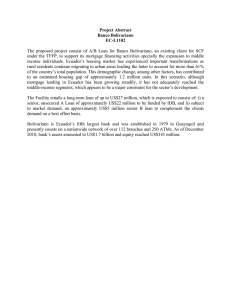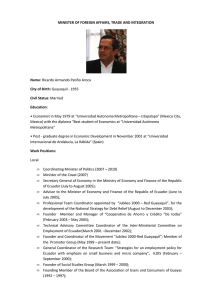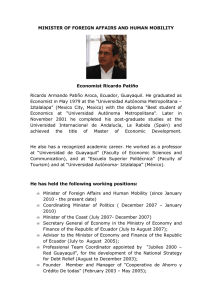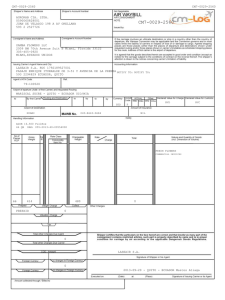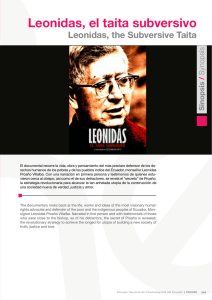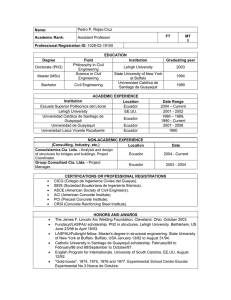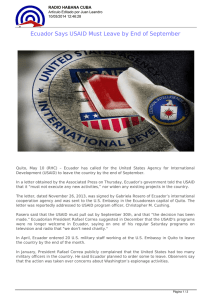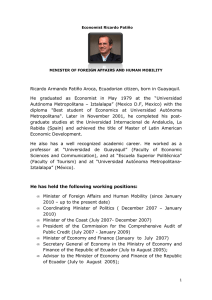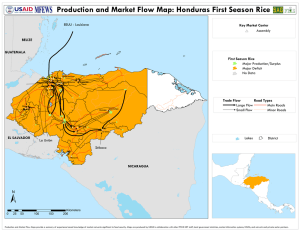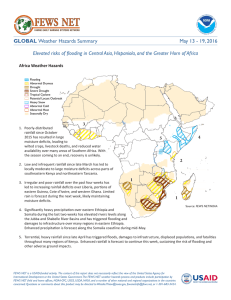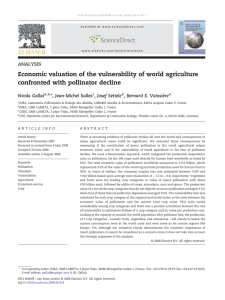USING GIS TO ASSESS RAINFALL RELATED RICE PRODUCTION
Anuncio
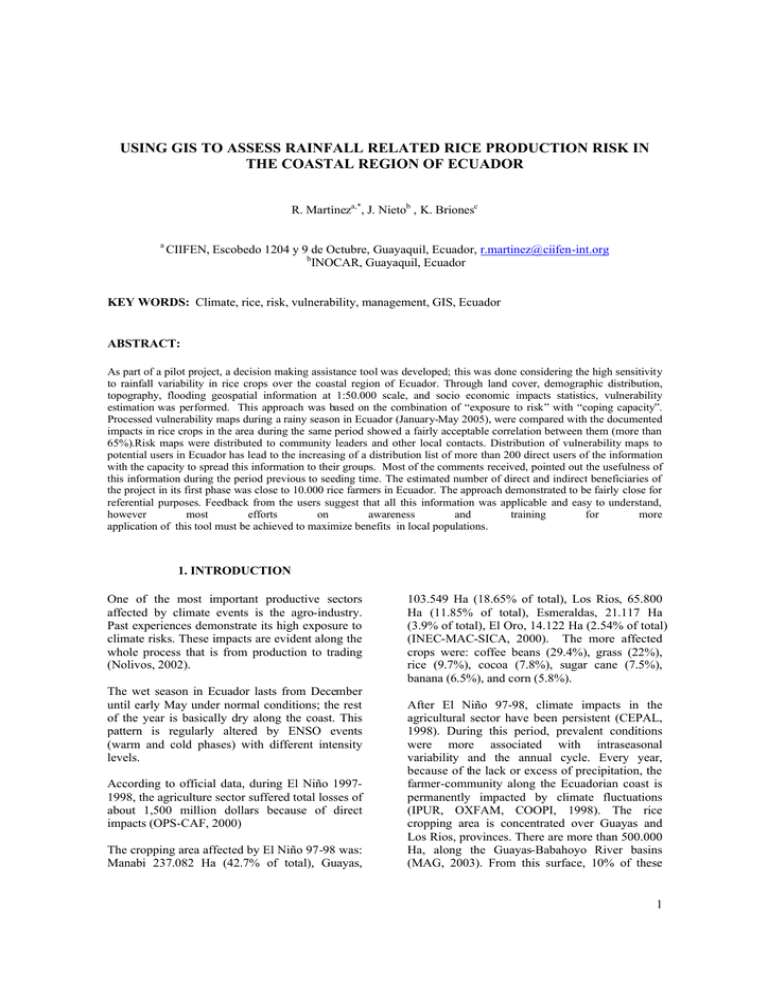
USING GIS TO ASSESS RAINFALL RELATED RICE PRODUCTION RISK IN THE COASTAL REGION OF ECUADOR R. Martíneza,*, J. Nietob , K. Brionesc a CIIFEN, Escobedo 1204 y 9 de Octubre, Guayaquil, Ecuador, [email protected] b INOCAR, Guayaquil, Ecuador KEY WORDS: Climate, rice, risk, vulnerability, management, GIS, Ecuador ABSTRACT: As part of a pilot project, a decision making assistance tool was developed; this was done considering the high sensitivity to rainfall variability in rice crops over the coastal region of Ecuador. Through land cover, demographic distribution, topography, flooding geospatial information at 1:50.000 scale, and socio economic impacts statistics, vulnerability estimation was performed. This approach was based on the combination of “exposure to risk” with “coping capacity”. Processed vulnerability maps during a rainy season in Ecuador (January-May 2005), were compared with the documented impacts in rice crops in the area during the same period showed a fairly acceptable correlation between them (more than 65%).Risk maps were distributed to community leaders and other local contacts. Distribution of vulnerability maps to potential users in Ecuador has lead to the increasing of a distribution list of more than 200 direct users of the information with the capacity to spread this information to their groups. Most of the comments received, pointed out the usefulness of this information during the period previous to seeding time. The estimated number of direct and indirect beneficiaries of the project in its first phase was close to 10.000 rice farmers in Ecuador. The approach demonstrated to be fairly close for referential purposes. Feedback from the users suggest that all this information was applicable and easy to understand, however most efforts on awareness and training for more application of this tool must be achieved to maximize benefits in local populations. 1. INTRODUCTION One of the most important productive sectors affected by climate events is the agro-industry. Past experiences demonstrate its high exposure to climate risks. These impacts are evident along the whole process that is from production to trading (Nolivos, 2002). The wet season in Ecuador lasts from December until early May under normal conditions; the rest of the year is basically dry along the coast. This pattern is regularly altered by ENSO events (warm and cold phases) with different intensity levels. According to official data, during El Niño 19971998, the agriculture sector suffered total losses of about 1,500 million dollars because of direct impacts (OPS-CAF, 2000) The cropping area affected by El Niño 97-98 was: Manabi 237.082 Ha (42.7% of total), Guayas, 103.549 Ha (18.65% of total), Los Rios, 65.800 Ha (11.85% of total), Esmeraldas, 21.117 Ha (3.9% of total), El Oro, 14.122 Ha (2.54% of total) (INEC-MAC-SICA, 2000). The more affected crops were: coffee beans (29.4%), grass (22%), rice (9.7%), cocoa (7.8%), sugar cane (7.5%), banana (6.5%), and corn (5.8%). After El Niño 97-98, climate impacts in the agricultural sector have been persistent (CEPAL, 1998). During this period, prevalent conditions were more associated with intraseasonal variability and the annual cycle. Every year, because of the lack or excess of precipitation, the farmer-community along the Ecuadorian coast is permanently impacted by climate fluctuations (IPUR, OXFAM, COOPI, 1998). The rice cropping area is concentrated over Guayas and Los Rios, provinces. There are more than 500.000 Ha, along the Guayas-Babahoyo River basins (MAG, 2003). From this surface, 10% of these 1 crops are independent of climate variability because they have autonomous irrigation systems. 90% of rice crops depend absolutely from the precipitations. This situation involves most of 150.000 rice farmers and more than 500.000 indirect dependants of rice activity. (MAG, 2003; MAG, 2004). In Ecuador, agricultural outcomes go beyond 1945 billion USD, and represent approximately 17% of PIB, with more than 60% of the total exportations, (CAF, 2000). The agriculture area employs more than 30% of the active economical population. The Main crops that exist in Ecuador are rice, corn and coffee. Historically main agricultural losses by provinces are distributed as follows: Guayas 35,83%, Los Ríos 25,825, El Oro, 13,84%, Manabi 7,43%, Esmeraldas 2,84%. The crops that are affected the most by provinces are: Manabi: Coffee, cocoa, corn, Guayas: rice and corn, Los Rios: rice and corn, El Oro: corn. From a total of 108,783 Ha. of transitional crops, 20.443 are affected by drought, 15.162 by frost, and 7.804 by floods. In the specific case of rice crops 54% of losses are related to climate events, and for corn 74% of losses are because of climate impacts. (CAF, 2000) One of the main factors responsible of this impact is associated with the lack of prevention in the agricultural sector, official announcements are not always accessible to farmers, and when they reach them, the users do not always understand. (UNDP-CIIFEN, 2005). Decision makers from the Government sector and individual farmers; do not use the available information, because in most of the cases, the climate statements do not express beginning of rainy season, and then how much rainfall will be expected during this period at least in terms of percentage above or below normal. (UNDP-CIIFEN,2005) the variables and the required elements to make decisions for the agriculture sector (Glantz, 2001). In the case of rice crops, the paramount information to be required is the approximate beginning of rainy season, and then how much rainfall will be expected during this period at least in terms of percentage above or below normal. (UNDP-CIIFEN, 2005) year an increasing circle of poverty. (UNDP-CIIFEN, 2005). According to several forums and publications, the risk is conceived as a multiplication between vulnerability by threat. There are other usable definitions with more complex involved implications. One of them is the definition of vulnerability as a multiplication of “exposure to risk” times coping capacity”. The main consequence when using this definition is to provide a framework that is policy relevant and that it focuses attention on building coping capacity, which is more achievable and useful than trying to eliminate the exposure to risk per se. This also means that vulnerability is a human construct. Some of these vulnerability indicators could be: the gross domestic product, human poverty index, total debt service, inflation food process, percentage of agriculture dependency, illiteracy rate, and several more. (UNDP, 2004). This pilot approach intends to make a relatively simple system to build climate vulnerability scenarios for rice crops in Ecuador, considering the aforementioned vulnerability definition which will be parameterized with socio economical indicators considered critical for this area in Ecuador and particular features of agriculture activities. An additional limitation is the low level of education in the farmers community, terms and numbers which express anomalies or expected conditions are not easy to understand, therefore, none further decision is derived from this information. Uncertainty leads to bad decisions and continuous impact in this sector, causing each 2 analysis of impacts in the zone was performed using DESINVENTAR Data base, (2004). 2. METHODOLOGY 2.2 Coping Capacity Analysis 2.1 The geospatial vulnerability analysis It is based on the following definition: Vulnerability = Exposure to risk x Coping capacity (1) Exposure to risk analysis Precipitation is considered as the most important natural hazard for rice crops because of the extreme dependence and sensitivity to rainfall intensity, persistence and temporal distribution. The system was designed to receive from users as an input parameter, the level of precipitation expected in this zone. This level was classified into three categories; high, medium and low (CORPOCALDAS - CIRR, 2003-2004). An analysis of rainfall time series during the period of 1960-2004 in eleven meteorological stations was performed. These stations were correlated between each other in order to obtain the best stations that can reproduce the spatial pattern of precipitation over the area being studied. The stations with the highest average correlation coefficients are listed in Table 1. Station Babahoyo Pichilingue Guayaquil Milagro Naranjal Salinas Average Corr. Coefficient 0.59 0.65 0.67 0.66 0.67 0.50 The next step was the estimation of coping capacity that was defined with the following socio economical indicators: - Maps of Human Poverty Index (INEC 2004). Maps of Illiteracy rate (INEC 2004) Maps with percentage of agriculture dependency (MAG, 2004). The cartographic information was reduced to 1:50.000 scale to be processed, the weight of each variable was: - Human Poverty Index (30%) Maps of Illiteracy rate (30%) Maps with percentage of agriculture dependency. (40%) 2.3 Maps and visual user interface. All maps were created using the ESRI Arc View package. Geospatial data was linked by a relational database. The user interface was developed in Visual Basic, and conceived to facilitate the construction of scenarios through the input of the expected conditions to visualize resulting vulnerability maps. The main template of the system is showed in Fig.No. 2. Table 1 Vulnerability was estimated by determining the “exposure to risk” as a direct function of flooding maps in the area of study. Flooding maps were built considering topographic configuration and soil features. This information layer was processed with the land cover information which classified and identified the rice crops in the area. The final step of the process was the map with the layer corresponding to “Exposure to Risk”. In order to obtain levels to categorize the “Exposure to Risk” and rainfall, a statistical Fig. No. 2 User interface template 3. RESULTS AND VALIDATION The obtained maps of vulnerability correspond from January-May 2005 as indicated in Fig. No.3. 3 The observed rainfall anomalies in the same period are showed in Fig. No.4. The maps indicating hits and fails between estimated vulnerability and impact information in the area are shown in Fig. No.5. The information of Fig No. 4 Observed Rainfall anomalies from January-May 2005 (Source: INAMHI -2005) Fig. No. 5 Hit and fail maps between estimated vulnerability and occurred impacts in the area from January-May 2005 (Source: National Civilian Defense of Ecuador, 2005). impacts was provided by The National Civilian Defense of Ecuador, 2005. Jan/05 Feb/05 Mar/05 Fig. No. 3 (a) Estimated Vulnerability maps for Rice Crops in Guayas and Los Rios provinces (Jan-Mar 2005). Rice Vulnerability- to rainfall exposure Rice Vulnerability- to rainfall exposure Vulnerability Vulnerability H M Rainfall Excess L M H Rainfall Deficit Apr/05 H M Rainfall Excess L M H Rainfall Deficit May/05 Fig. No. 3 (b) Estimated Vulnerability maps for Rice Crops in Guayas and Los Rios provinces (Apr-May 2005). Since the estimated vulnerability maps for the indicated periods, medium to low vulnerability was expected during January and February 2005; low vulnerability in March 2005; and medium vulnerability for April and May 2005. The maps of observed rainfall anomalies showed negative monthly anomalies along the whole period from January –May 2005 which is a very atypical feature for this zone in Ecuador (INOCAR, 2002). In spite of an irregular rainfall distribution, the percentage of hits during the observed period is more than 65% in each one of the months. It was evident a good performance of the estimation during March 2005, which is the rainiest month of the year in this area (INOCAR,2003). Fails of the estimated vulnerability are mostly allocated in the southern zone of the area. These fails are probably associated with an overestimation of vulnerability under the expected conditions (COPEFEN, 2000). Vulnerability maps were distributed through community leaders and other local contacts. Distribution of maps to potential users in Ecuador has derived since then, in an increase of a distribution list to more than 200 direct users of the information with the capacity to disseminate it to their influence groups. Most of the received comments pointed out more usefulness of this information during the period previous to seeding time. The provided information was classified as experimental. The distributed information included a brief and comprehensive explanation on how to use the estimations. Comments and feedback about the maps were received during the experimentation period and during the year 2005. Most of the received suggestions from users will be implemented in the next version of the prototype. 4. DISCUSSION 4 Vulnerability and risk concepts could be very abstract definitions when the final product is received by users. Vulnerability is a human construct, therefore, rice crops cannot be vulnerable, people who depend on the food and income from these crops are vulnerable. There are a wide variety of concepts depending on natural hazards, regions or situation. However, the approach employed was easily understood by users. Although, the vulnerability concept applied in this project combines interaction between natural hazard and the exposed area, the main added value to this approach was the inclusion of coping capacity parameterization. This approach gives to the system a framework that is, policy relevant and that it focuses attention on variables that can be managed with certain coordinated actions ,instead of the elimination of “exposure to risk” per sea, The main difficulties to quantify “coping capacity” are the limitations to include all the social and economical variables that can module this concept. However, to handle many variables could lead to distort the final estimation if they are not properly weighted under scientific criteria. In this case, the failures are mostly associated with the overestimation of the vulnerability. The results suggest the probable influence of the relatively low resolution of rainfall maps which were constructed with few stations. Another factor could be the lack of information that can change significantly the level of “coping capacity” and that was not included in this project. Some of the excluded factors are: the potential capacity to install emergent pumping systems, small infrastructure devices that can be built during the rainfalls events or emergency irrigation systems to cope with deficit rainfall. The user interface of the project enabled them to build scenarios on their own. Users can get a referential idea of the vulnerability in a particular area through the estimated rainfall level. Therefore, as a result, they get information to take the necessary actions to reduce existence vulnerability levels, even if the estimation is roughly accurate. It is evident that this tool was not fully accessible to the wide community of users. More interfaces are needed to translate the potential benefits of this approach. Some of the elements that must be enhanced are the awareness and the identification of more key contacts that can disseminate the provided information on time. Media and governmental agencies could be a suitable partner in this endeavor, but more structural frameworks must be enhanced first. 5. CONCLUSIONS Levels of uncertainty to estimate vulnerability for rice crops are probably due to low resolution of rainfall spatial distribution and the over parameterization of coping capacities variable. The approach demonstrated to be fairly approximated for referential purposes, therefore, it was applicable and easy to understand for target users. Most efforts on awareness and training to apply this tool must be achieved to maximize benefits in local populations. The estimation of vulnerability for rice crops in this zone of Ecuador is aimed to enhance the risk management through the building of coping capacities. This is more feasible and useful than reduction of the “exposure to risk” because in the case of rice is not applicable. The obtained results and learnt experiences during this pilot can lead to a second phase of the project, expanding it to more geographic areas and other crops. 6. REFERENCES Boletines del Servicio de Información y Censo Agropecuario del Ministerio de Agricultura y Ganadería del Ecuador SICA, 2002-2004 CAF, MSPE, SENPLADES: Matriz del eslabón de la cadena de Salud, de Agua y de Agricultura, documento de trabajo, Quito, 2005 CAF: Las Lecciones de El Niño Ecuador, Memorias del Fenómeno El Niño 1997-1998, Retos y propuestas para la región andina, CAF, Caracas, 2000 CEPAL: Ecuador: Evaluación de los efectos socio-económicos del Fenómeno El Niño 97-98, junio 1998 CIRR, Ponencia para la Conferencia Interamericana de Reducción de Riesgos: Sistema Distrital de Prevención y Atención de Emergencias, Manejo de Riesgo en Bogotá 5 Lecciones Aprendidas, Colombia, 2004. Manizales- CORPECUADOR: Plan Maestro de Rehabilitación y Reconstrucción de las Zonas afectadas por el Fenómeno de El Niño, ESPOLUniversidad Católica de GuayaquilCOA, Guayaquil, Ecuador, 2003 CORPOCALDAS: Gestión Integral del Riesgo en el Departamento de Caldas, Colombia, Ponencia para la Conferencia Interamericana de Reducción de Riesgos, Manizales-Colombia, 2004 Daqui D.,: Análisis del riesgo espacial, temporal y semántico a partir del registro de desastres por eventos ENSO y variabilidad climática anual en Ecuador, Escuela Politécnica Nacional, tesis inédita, facultad de Ingeniería Civil, 2004 Defensa Civil del Ecuador: Inventario de impactos de la estación húmeda en la costa del Ecuador, Guayaquil, 2005 DESINVENTAR: Bases de desastres DesInventar, Escuela Politécnica del Ejército, Quito, 19802002 Gutiérrez C. et all.,: Evaluación Hidrológica de El Niño 1997- 1998, INAMHI, Quito, 1999 INECI-PNUD: Resultados del taller regional de América Latina y el Caribe preparatorio de la conferencia mundial de reducción de desastres: observaciones al documento “desarrollo de la resiliencia de las naciones y comunidades ante los desastres: elementos para un programa de acción 2005-2015 versión borrador 9 agosto 2004”, Quito, 2004. INAMHI, Instituto Nacional de Meteorología e Hidrología: Anuarios meteorológicos, Quito, 1982-2002. Posibles Escenarios de Reconstrucción, IPURCOOPI-OXFAM, Guayaquil, 1998 Junta Provincial de Defensa Civil del Guayas: Sistema de planificación de emergencias por inundaciones, Guayaquil, 2004 Nolivos, I.: Estudio del Impacto de los eventos El Niño 1991-1992 y 1997-1998 sobre los rendimientos de cultivo de arroz y maíz en el litoral ecuatoriano., 2002 OPS: Crónicas de Desastres, Fenómeno El Niño 1997-1998, 2000. Registros de producción del Ministerio de Agricultura y Ganadería MAG, 2000, 2001, 2002, 2003, 2004, 2005. ROSSEL F.,: Influencia de El Niño sobre los regímenes hidro-pluviométircos del Ecuador, ORSTOM-INAMHI-INSEQ, inédito, Quito, 1997 UNDP- BCPR-DRU-OCHA,: Informe de Misión para el diagnóstico y formulación de recomendaciones para la construcción de un sistema nacional de gestión de riesgos, 17, PNUD Ecuador, 2004. UNDP- Min. Relaciones Exteriores Ecuador: Acta del Taller Regional de América Latina y el Caribe preparatorio de la Conferencia Mundial de Reducción de Desastres, Quito, 2004. UNDP- OCHA- ISDR,: Project to Strengthen capacities to manage and reduce El Niño disaster risks in the Andean Region, Preparatory Assistance Document for the Bureau for Crisis Prevention and Recovery – Disaster Reduction Unit, 11, 2004. 7. Acknowledgements INOCAR, Instituto Oceanográfico de la Armada: Atlas meteorológico del mar ecuatoriano, Guayaquil, 2002. IPUR, OXFAM, COOPI: “Análisis situacional de los impactos del Fenómeno El Niño en la costa ecuatoriana y posibles escenarios de reconstrucción”, 1998. To CIIFEN for the support for the Pilot Project. To INOCAR for the provided assistance on data, and imagery processing needs. To INAMHI for the provided data. To National Civilian Defense Office for the provided information. To Oc. Freddy Hernandez d Ing. Alfonso Romero for the technical support. IPUR,: Análisis Situacional de los Impactos del Fenómeno El Niño en la Costa Ecuatoriana y 6
